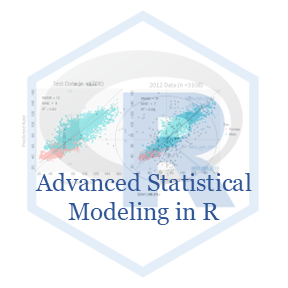3. Generalized Multilevel Model
This tutorial introduces the concept of Generalized Multilevel Models (GMLMs) and their application in analyzing hierarchical data with non-normal outcomes. GMLMs extend the framework of linear mixed-effects models to accommodate a broader range of response distributions, including binary, multinomial, count, and ordinal data. This tutorial covers following topics:
3.2. Multilevel Multinomial Model
3.5 Generalized Linear Mixed Models using Adaptive Gaussian Quadrature
3.6. Generalized Additive Mixed Models
Introduction to Generalized Multilevel Models (GMLMs)
A Generalized Multilevel Model (GMLM) is a statistical framework used to analyze data that has a hierarchical or nested structure while also accommodating non-normal outcomes (e.g., binary, count, ordinal, or other data types). It extends the concept of linear mixed-effects models (used for continuous data) to a broader range of response distributions by leveraging the framework of generalized linear models (GLMs).
Key Concepts of GMLM
Multilevel or Hierarchical Structure:
- Multilevel data arises when observations are grouped at different levels. For example, students nested within schools, or repeated measurements taken from the same individual.
- GMLMs model relationships at different levels simultaneously, accounting for the dependence among observations within the same group.
Generalized Framework:
Unlike standard multilevel models that assume normally distributed outcomes, GMLMs allow for different types of distributions for the response variable:
- Binary outcomes: Logistic regression (e.g., whether a student passed or failed).
- Count outcomes: Poisson regression (e.g., the number of accidents per year).
- Proportional outcomes: Binomial regression (e.g., proportion of successes in trials).
- Ordinal outcomes: Ordinal logistic regression (e.g., levels of satisfaction).
Random Effects:
- GMLMs include random effects to capture the variability within groups (e.g., schools or individuals) and across groups.
- Random effects can be added at multiple levels, allowing the model to address the correlation between observations within the same group.
Fixed Effects:
- Fixed effects represent the population-level relationships between predictors and the outcome variable, consistent across all groups.
Link Function:
- A link function transforms the expected value of the response variable to a linear predictor, enabling the model to handle different distributions. For example:
- Logit link for binary outcomes.
- Log link for count data.
- A link function transforms the expected value of the response variable to a linear predictor, enabling the model to handle different distributions. For example:
Here is a step-by-step explanation of GLMM, including its mathematical formulation:
Data Structure and Response Variable
The response variable \(Y_{ij}\) may follow different distributions (e.g., normal, binomial, Poisson) depending on the nature of the data. The choice of distribution is determined by the type of outcome variable and the research question. For example, binary outcomes (e.g., pass/fail) are modeled using logistic regression, while count data (e.g., number of events) are modeled using Poisson or negative binomial regression. \(i\) indexes groups (e.g., schools), and ( j ) indexes individuals within groups (e.g., students).
The linear predictor \(\eta_{ij}\) in a GLMM consists of:
- Fixed effects: Systematic effects shared across all observations.
- Random effects: Group-specific deviations accounting for variability within hierarchical levels.
Mathematically:
\[ \eta_{ij} = \mathbf{X}_{ij} \boldsymbol{\beta} + \mathbf{Z}_{ij} \mathbf{u}_i \]
Where:
\(\mathbf{X}*{ij}\): A vector of predictors for the fixed effects.
\(\boldsymbol{\beta}\): Coefficients for the fixed effects.
\(\mathbf{Z}{ij}\): A vector of predictors for the random effects.
\(\mathbf{u}_i\): Random effects for group \(i\), typically assumed to follow \(\mathbf{u}_i \sim N(0, \boldsymbol{\Sigma}\).
The Link Function
A link function \(g(\cdot)\) relates the mean of the response \(\mu_{ij}\) to the linear predictor (\(\eta_{ij}\):
\[ g(\mu_{ij}) = \eta{ij} \]
The choice of \(g(\cdot)\) depends on the distribution of \(Y_{ij}\)):
Identity link \(g(\mu) = \mu )\): For normal outcomes.
Logit link \(g(\mu) = \log \frac{\mu}{1-\mu}\): For binary outcomes.
Log link \(g(\mu) = \log(\mu)\): For count data.
Random Effects
The random effects \(\mathbf{u}_i\) capture unobserved variability at the group level. For example:
In a student-school dataset, \(u_i\) accounts for differences between schools.
Random effects are modeled as \(\mathbf{u}_i \sim N(0, \boldsymbol{\Sigma})\), where \(\boldsymbol{\Sigma}\) is the covariance matrix.
The response variable’s distribution can be written as:
\[ Y_{ij} \sim f(Y_{ij} \mid \eta_{ij}) \]
Where \(f(\cdot)\) is the density or probability mass function.
Hierarchical Model
For a two-level GLMM:
- Level 1 (Individual level):
\[ g(\mu_{ij}) = \eta{ij} = \mathbf{X}_{ij} \boldsymbol{\beta} + \mathbf{Z}_{ij} \mathbf{u}_i \]
- Level 2 (Group level):
\[ \mathbf{u}_i \sim N(0, \boldsymbol{\Sigma}) \]
Likelihood Function
The likelihood function accounts for both fixed and random effects. The joint likelihood is:
\[ L(\boldsymbol{\beta}, \boldsymbol{\Sigma} \mid \mathbf{Y}) = \prod_{i=1}^{G} \int \prod_{j=1}^{n_i} f(Y_{ij} \mid \eta_{ij}) , \phi(\mathbf{u}_i; 0,* \boldsymbol{\Sigma}) , d\mathbf{u}_i \]
Where:
\(f(Y*{ij} \mid \eta{ij})\) : Conditional distribution of \(Y{ij}\).
\(\phi(\mathbf{u}\_i; 0, \boldsymbol{\Sigma})\): Density of random effects.
This integral often requires numerical approximation (e.g., using Maximum Likelihood Estimation or Bayesian methods).
Interpretation of Parameters
- Fixed effects \(\boldsymbol{\beta}\): Describe the overall relationship between predictors and the response.
- Random effects \(\mathbf{u}_i\): Describe group-specific deviations.
Summary and Practical Applications
Generalized Multilevel Models (GLMMs) provide a flexible framework for analyzing hierarchical data with non-normal outcomes. By extending the concept of linear mixed-effects models to generalized linear models, GLMMs can handle a wide range of response distributions, including binary, count, and ordinal data. Key components of GLMMs include fixed and random effects, link functions, and hierarchical structures. These models are widely used in various fields, such as education, health, and social sciences, to account for the complex dependencies in multilevel data. GLMMs can be estimated using software packages like lme4 in R or glmmTMB for more complex models.
References
“Generalized Linear Mixed Models: Modern Concepts, Methods and Applications” by Charles E. McCulloch, Shayle R. Searle, and John M. Neuhaus
- This book provides a comprehensive introduction to generalized linear mixed models, including random intercept models, with practical examples in R.
Chapter 4 - Generalized Multilevel Model for Examining Intraindividual Covariation
Intro to Frequentist (Multilevel) Generalised Linear Models (GLM) in R with glm and lme4
Modeling Count Outcome using the Generalized Multilevel Model


